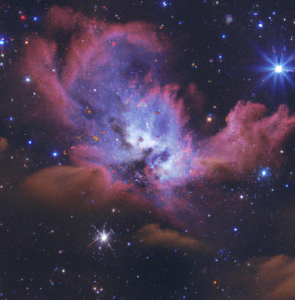How to See a Lagoon Nebula With A Telescope?

The Lagoon Nebula is an emission nebula with an active area of star formation full of gas and dust. It is located in the constellation Sagittarius around 5000 light years away. We can see the glow of the embedded star cluster NGC 6530. It has a luminosity of magnitude 6 that makes it a nice choice to observe with a telescope.
Quick Guide to Observe Lagoon Nebula
The ideal time to view the Lagoon Nebula is during the Northern Hemisphere’s summer, from June through August. Make sure you’re using a star app; it will make the process much easier. Discover the constellation of Sagittarius. From the southern hemisphere, look northward. Look south if you are in the northern hemisphere. Find the Lagoon Nebula by using the star chart.
You may achieve stunning vistas with great contrast by using 8-inch telescopes with at least 1000mm of focal length. Lagoon’s true hue can be seen thanks to light pollution filters (Optolong L-Pro).
Make sure you are using a star app, it will greatly help with the process.
Try to use reliable star charts available online. “See it With a Small Telescope” provides a constellation chart made by the International Astronomical Union and Sky & Telescope Magazine. These charts are modified to indicate certain features or objects of the night sky. Keep in mind that the stars with different magnitudes are given as different size dots in the sky. The larger the dot, the brighter the sky. Another thing to notice is the orientation of the star charts. However, you can change it if you use a star app like Stellarium or others.
How to find Lagoon Nebula?
- Find out the Sagittarius constellation.
- Look northward from the southern hemisphere. If you are in the northern hemisphere, look southward. Follow the star chart and identify the Lagoon Nebula.
What is the best time to observe the Lagoon Nebula?
The summer months of June to August in the Northern Hemisphere are the best time to observe the Lagoon Nebula. The table below shows the rise and set times of the Lagoon Nebula.
| Month | Transit | Rise | Set | Notes |
| January | 11:00 | 06:00 | 15:30 | Not observable· |
| February | 08:30 | 04:00 | 13:30 | Not observable· |
| March | 08:00 | 03:30 | 12:30 | |
| April | 06:00 | 01:30 | 10:30 | |
| May | 04:00 | 23:30 | 08:30 | |
| June | 02:00 | 21:30 | 06:30 | Best after midnight |
| July | 00:00 | 19:30 | 04:30 | Visible all night |
| August | 22:00 | 17:00 | 02:30 | Best before midnight |
| September | 20:00 | 15:00 | 00:30 | |
| October | 18:00 | 13:00 | 22:30 | |
| November | 15:00 | 10:00 | 19:30 | Not observable· |
| December | 13:00 | 08:00 | 17:30 | Not observable· |
2 Tips to observe the Lagoon Nebula in the best way.
- Choose a night close to the new moon phase.
- Use the lowest power eyepiece to spot it easily. Then increase the power gradually to get the magnified view.
What can you see near the Lagoon Nebula?
- A brighter nucleus of the Lagoon Nebula that is separated by a rift from an open star cluster on the other side is visible on one side.
- On the eastern side, you will find the open star cluster NGC 6530.
- Numerous blue and white stars and bright and dark bands of Nebulae.
- Head north to get the Trifid Nebula, M 20.
- The pair of globular clusters of NGC 6544 and NGC 6553 at the southeast of the Lagoon Nebula.
- Colorful open cluster NGC 6520 at around -28 degrees down of the Lagoon Nebula
What telescope to see Lagoon Nebula?
The 16 LX 600 ACF f/ 8, Sky-Watcher 12″ f/3.93 Quattro Imaging Newtonian, and Celestron Starsense Explorer 10″ Dobsonian are great telescopes to see the Lagoon Nebula. A list of telescopes to see Lagoon Nebula has more telescope options that can see Lagoon Nebula very clearly.
What size telescope to see Lagoon Nebula?
A 6-inch telescope is enough to see the Lagoon Nebula. But by using 8-inch telescopes with at least 1000mm of focal length, you will get amazing views with sharp contrast. But they will not reveal the natural color and nearby objects. You need at least a 10-inch telescope to observe the color of the Lagoon Nebula along with the nearby star clusters and nebulae.
What magnification is required to observe the Lagoon Nebula?
The magnification of the telescope to observe the Lagoon Nebula should be at least 75x-100x. If the telescope allows more magnification, you can use that to get better views. 100x-400x magnification with a 10-14 inch aperture will allow you to sense the colors of the Lagoon Nebula.
What filters are the best to see the Lagoon Nebula?
- Light pollution filters (Optolong L-Pro) reveal the natural color of Lagoon.
- A narrowband h-alpha filter is the best for astrophotography.
- The Astromania 2″ O-III Filter provides good performance in both dark skies and light-polluted areas.
Enjoying Lagoon Nebula? Here are other things to see with your telescope.
Lagoon Nebula is a wonderful object to view. However, Viewing Nebula Through A Telescope can guide you to find other nebulae. The same telescope you are using for viewing Lagoon may reveal planets of our solar system, their moons, and floating asteroids. Our nearby galaxy Andromeda and other star clusters also appear with a great view. Go through the ‘List of things to see with a telescope’ to get a shortlist of several night sky objects you can observe with different telescopes.
